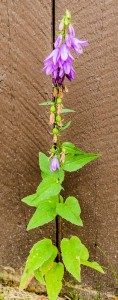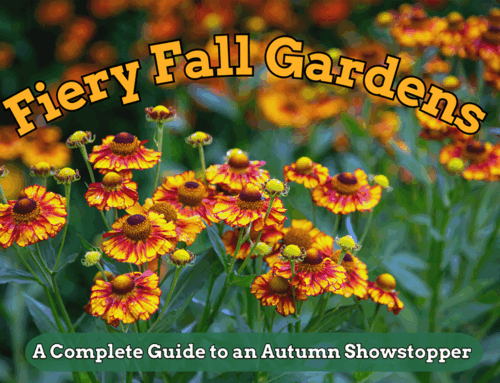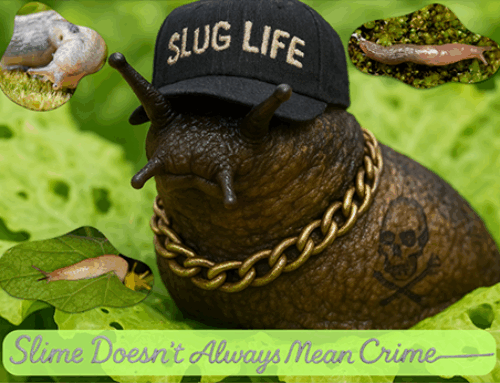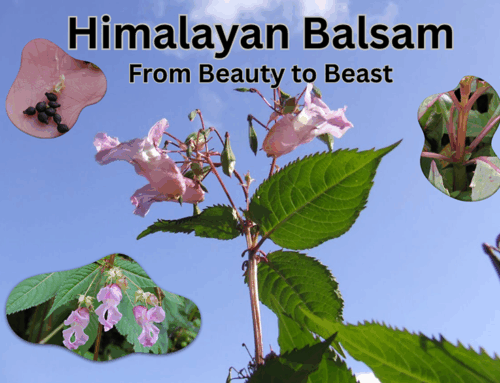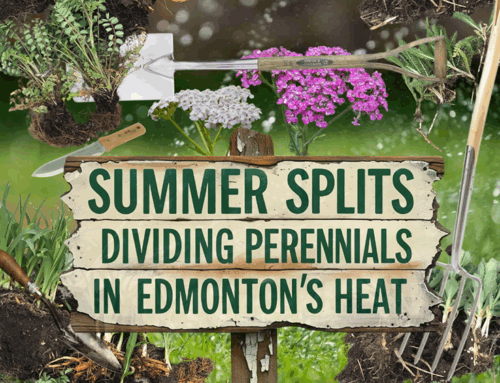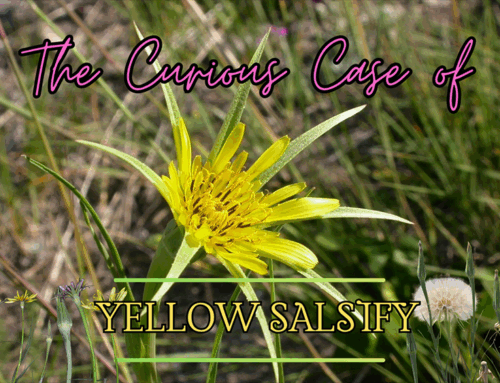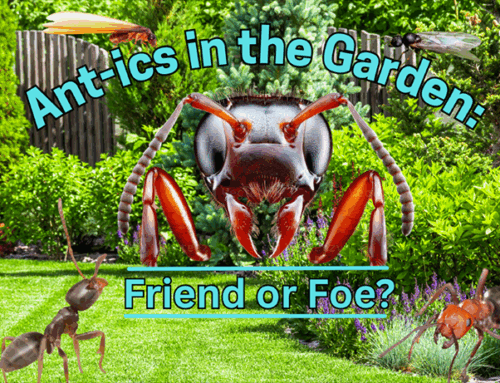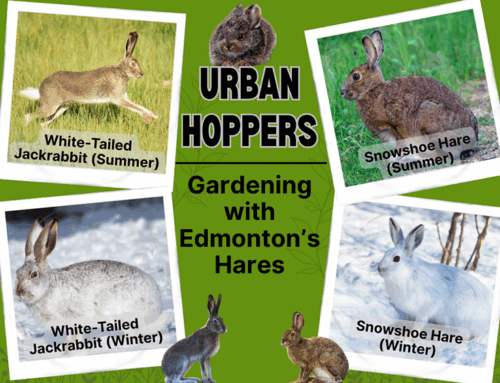Creeping It Real: The Creeping Bellflower Invasion
by Aislinn Case and Brett Kerley
Creeping bellflower (Campanula rapunculoides), also known as creeping bluebell, may look charming with its nodding purple-blue bells—but don’t be fooled. This plant is a designated noxious weed in Alberta and poses a serious threat to both gardens and natural ecosystems.
Noxious and prohibited noxious weeds are regulated under the Alberta Weed Control Act, and the weeds under this act are determined by the Minister of Environment and Protected Areas at the provincial level. There are no plants regulated under City of Edmonton bylaw at this time. As such, as a municipality, we follow the direction of the Alberta Weed Control Act when managing regulated invasive plants, which declares noxious weeds must be controlled, and prohibited noxious weeds must be destroyed. At this time, creeping bellflower remains a noxious weed.
The Problem With Creeping Bellflower
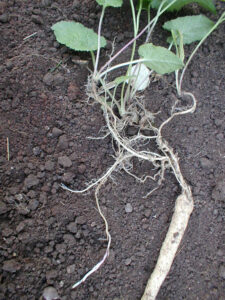 Creeping bellflower is a highly invasive perennial that spreads aggressively via both seeds and a network of thick, creeping white roots called rhizomes and tubers. Once established, it is extremely difficult to eliminate.
Creeping bellflower is a highly invasive perennial that spreads aggressively via both seeds and a network of thick, creeping white roots called rhizomes and tubers. Once established, it is extremely difficult to eliminate.
- Roots can grow deep into the soil (sometimes more than a metre down, 3 ½ feet)
- Even small root fragments left behind can regenerate into new plants
- Each plant can produce thousands of seeds that are easily dispersed by wind, water, or animals
It tolerates a wide range of conditions—sun or shade, dry or moist soil—and can easily outcompete ornamental plants and native species, including those important to pollinators.
Identification
Look for the following characteristics:
- Leaves: Heart-shaped with serrated edges, alternately arranged on a single, unbranched stem.
- CBF often grows in dense patches or monocultures.
- Height: Grows between 20–60 cm (8–24 in), but may get taller in ideal conditions
- Flowers: Blue to purple, bell-shaped, dangling from a tall spike in summer (typically June to August)
- Roots: Thick, white tuberous roots, often tangled around the roots of nearby plants
Creeping bellflower can often be spotted in yards, alleys, boulevards, and other disturbed areas throughout Edmonton and beyond.
Prevention
- Avoid “mystery” seed mixes that don’t clearly list all included species—some wildflower mixes have been found to contain creeping bellflower
- Check new plant purchases—creeping bellflower is sometimes unintentionally included in soil or plant trades
Educate neighbours and gardeners in your area. There are many properties with creeping bellflower in Edmonton, and it is notoriously difficult to manage. Shared awareness makes a big difference in control efforts. You can even print off this article and place it in their mailbox. If that doesn’t work, you can report it by calling 311 or entering it on the 311 app. 311 inquiries are received and triaged based on species abundance and ability to cause harm. Prohibited noxious weeds are a greater priority within the City than noxious weeds like creeping bellflower, because it is more likely that the prohibited noxious weeds can still be eradicated. Citizens who use 311 are welcome to call and quote the ticket number at the bottom of their inquiry to receive more information. I suggest this if you find the outcome of your inquiry unsatisfactory.
Control
Eradication is very difficult once established, so the goal is control and containment. As far as we know, no chemicals have worked. While glyphosate can be effective against creeping bellflower, it typically requires multiple applications, as the plant is known to resprout from remaining root fragments. Given this, I prefer a mechanical approach, as it often provides a more definitive and immediate solution. Here are the key strategies we recommend:
Hand Pull
- Pulling off the leafy tops helps weaken the plant by preventing energy storage in the roots
- This won’t kill the plant, but repeated pulling can exhaust the tubers over time
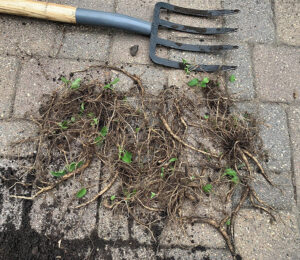 Dig Out Roots
Dig Out Roots
- Dig deeply and remove as many tubers as possible. It is essential to carefully extract all root material from the loosened soil to prevent regrowth. Where feasible, I try to dig to a depth of 8 to 12 inches to ensure maximum root removal. Having said that, I’ve known gardeners in Edmonton to have their whole yard excavated down several feet, then being replaced with new soil, only for it to show up again in a few years!
- This is labour-intensive and may require removing nearby plants whose roots are intertwined
- Be meticulous—tiny root pieces left behind can regrow. I can hear you cursing!
Preventing Seed Spread
- Cut off flowering spikes before they set seed
- Dispose of the flower stalks and root pieces properly (see below)
Important: Do not compost creeping bellflower or dispose of it in your green organics bin. Always bag it and put it in your black garbage bin to prevent spread.
Is Creeping Bellflower Edible?
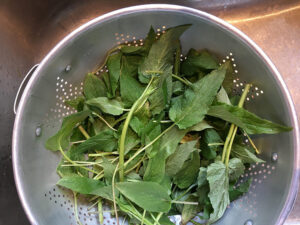 Surprisingly, yes—parts of creeping bellflower (Campanula rapunculoides) are edible, and it has a history of limited medicinal and culinary use in some cultures.
Surprisingly, yes—parts of creeping bellflower (Campanula rapunculoides) are edible, and it has a history of limited medicinal and culinary use in some cultures.
Edible Parts:
- Leaves: Young, tender leaves can be eaten raw in salads or cooked like spinach. They have a mild, slightly bitter taste.
- Roots: The fleshy white tuberous roots are said to be edible and mildly sweet, somewhat like parsnips. They can be roasted or boiled.
- Flowers: Edible as a garnish, with a slightly sweet flavor.
Note: Eating the roots is one way to get revenge on this persistent invader—but make absolutely sure you’ve correctly identified the plant before consuming. It can be easily confused with toxic lookalikes, especially in the early stages of growth.
Medicinal Uses (For Historical Interest Only)
Historically, creeping bellflower has been used in folk medicine for:
- Mild anti-inflammatory properties
- Soothing sore throats or coughs (flower infusions)
- Wound care when mashed and applied externally
However, these uses are not well-documented or scientifically supported, and the plant has not been evaluated for safety or efficacy in any modern medical context.
Caution: There are no approved medicinal uses of creeping bellflower in modern herbal medicine, and self-medicating with wild plants can be dangerous. Always consult a knowledgeable herbalist or health professional before using any wild plant medicinally.
Plant This Instead
Love the look of those bell-shaped blooms? You’re not out of luck. There are many non-invasive bellflowers available:
- Cultivated Campanula species: Garden-friendly and well-behaved
- Native harebell (Campanula alaskana): A delicate, locally adapted alternative with smaller flowers and shorter stature. It doesn’t spread aggressively and supports pollinators
More about Alberta’s native harebell: Alcla Native Plant Portrait – Harebell
More Noxious Weeds to Watch For
Creeping bellflower isn’t the only invader. Be on the lookout for:
- Bighead knapweed (Centaurea macrocephala) – Prohibited noxious weed
- Himalayan balsam (Impatiens glandulifera) – Prohibited noxious weed
- Canada Thistle (Cirsium arvense) – Noxious weed
Learn more about invasive species in Alberta: Alberta Invasive Species Council
In Conclusion
Creeping bellflower is beautiful, but it’s bad news for your garden and native biodiversity. Take early action when you spot it. Persistence and proper disposal are key.
If you’ve seen creeping bellflower in your neighbourhood, consider sharing this information—because invasive species don’t respect property lines.
Take care and don’t let the bells toll for your garden!


